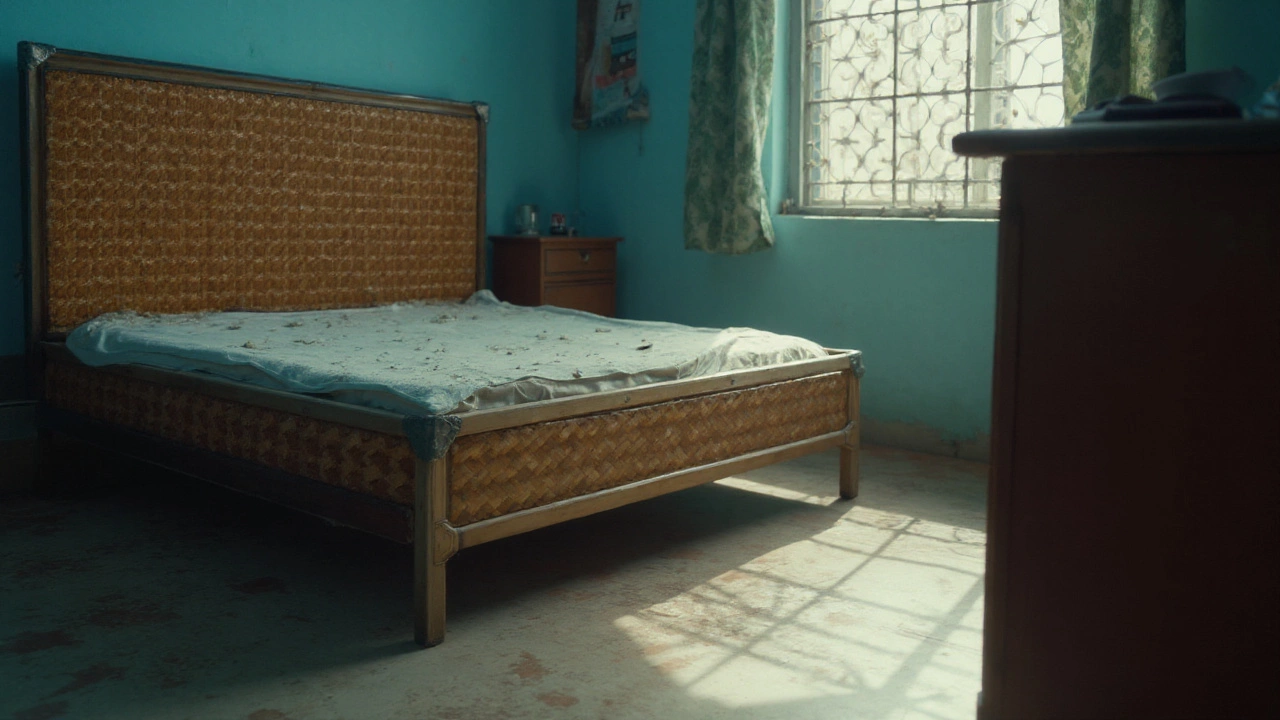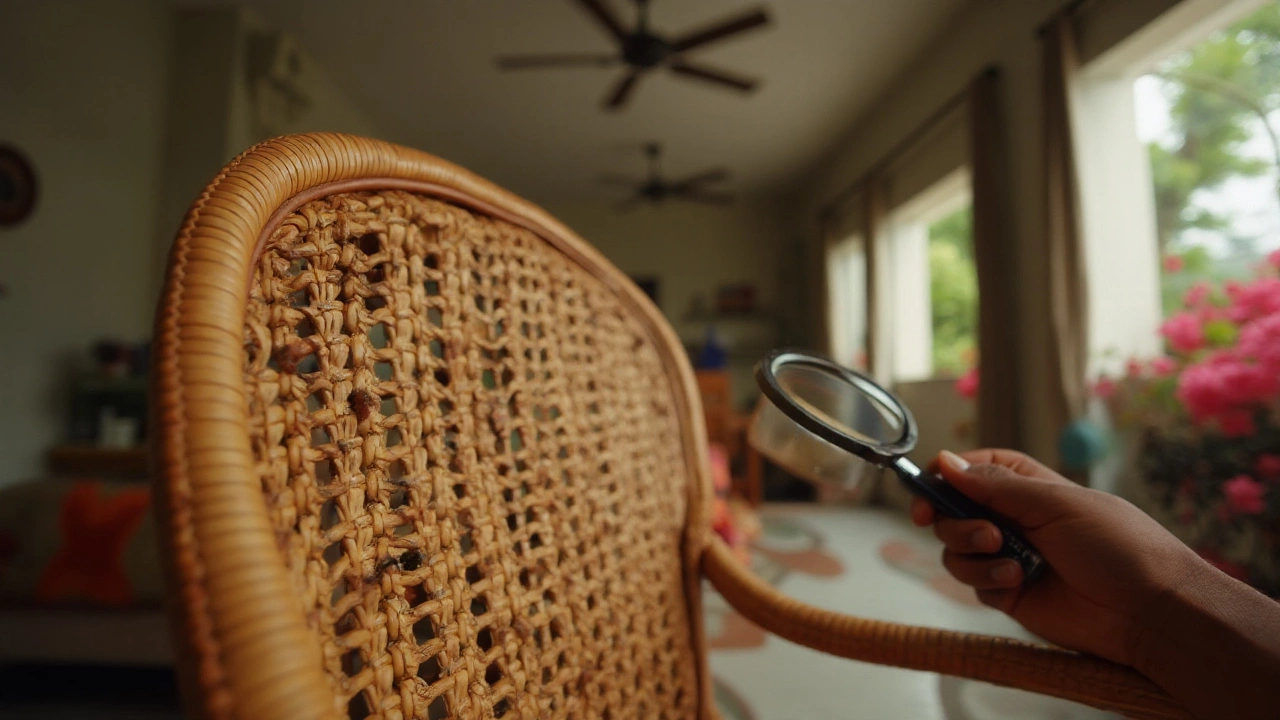You brought home a gorgeous woven chair, and now you’re itching-figuratively and literally-about hitchhikers. Can bed bugs live in wicker furniture? Yes. Wicker’s weave creates dense, shaded micro-gaps that are almost tailor-made as hiding spots for bed bugs at every life stage. That doesn’t mean your chair is doomed. It means you need smart inspection, the right tools, and a plan that actually works in the real world.
Bed bugs (Cimex lectularius) are human-biting insects that hide in cracks (down to ~1 mm), feed mostly at night, lay 1-5 eggs per day, and survive months without a blood meal at 18-22°C. Wicker furniture is a woven construction (often rattan, cane, bamboo, or resin) with intersecting strands and voids that create ideal harborage spaces for small insects.
Short answer: they can, and they do. But with a careful inspection and targeted control-heat, steam, desiccant dusts, and good containment-you can clear them from woven pieces without tossing everything to the curb. Here’s the full playbook.
TL;DR
- Yes-bed bugs can live in wicker. The weave provides countless tiny cracks, perfect for eggs, nymphs, and adults.
- Look for pepper-like fecal spots, pale cast skins, eggs cemented in seams, and live bugs in the tightest intersections.
- Steam (≥100°C at the tip), targeted desiccant dust, and structural sealing beat sprays alone.
- Natural rattan traps more bugs than smooth resin wicker; metal frames are lowest risk.
- If activity persists after two rounds of treatment, call a licensed pest manager familiar with the AEPMA Code of Practice.
Why wicker is such a good hideout
Wicker has two things bed bugs love: tight gaps and complex geometry. Where a flat timber board offers a few cracks, a woven panel offers hundreds. Each strand intersection is a shaded pocket with just enough texture for eggs to adhere and just enough depth for nymphs to tuck in.
Rattan is a natural vine material with porous fibers and microfissures that increase surface texture and egg adhesion for bed bugs. versus Resin wicker (HDPE synthetic) has smoother, more uniform strands that are a bit less hospitable; still, the weave’s voids remain viable harborage spots.
Semantic connections to keep in mind: bed bugs use microfissures to avoid desiccation; the weave reduces air movement and light; and the frame joints (especially where wicker meets wood) act as warm shelters near people.
Species and climate: does it matter?
Two bed bug species show up in homes: Cimex lectularius the common bed bug in temperate regions, active across Australia’s southern cities and Cimex hemipterus the tropical bed bug, more frequent in warmer northern zones and travel-linked infestations . Both will occupy wicker, but C. hemipterus tends to spread faster in warmer homes.
Authoritative guides like the AEPMA Code of Practice and university extension programs agree on this: structure and proximity to sleeping areas matter more than the furniture’s label. If a woven chair sits by a bed or lounge where people rest, it’s fair game.
How to identify bed bugs in wicker (what to look for)
Skip the guesswork. Here’s a field-tested checklist.
- Fecal spotting: tiny black dots that bleed into a damp wipe-commonly along the weave intersections and underside rails.
- Cast skins: papery, pale husks caught in the tightest corners or under the seat panel.
- Eggs: white, rice-grain specks (~1 mm) cemented along inner weaves; they don’t brush off easily.
- Live stages: nymphs (translucent to tan) and adults (reddish-brown, apple-seed size) packed into crevices and where wicker meets frame.
- Odor: a faint sweet, musty smell in heavier infestations.
Pro tip: use a strong flashlight and a thin plastic card. Slide the card along strand seams; anything dislodged onto a white tray tells you what’s living there.
Wicker vs other materials: which is riskier?
| Material | Harborage density | Inspection difficulty | Steam effectiveness | Dusting suitability | Typical outcome |
|---|---|---|---|---|---|
| Natural wicker (rattan/cane) | High (porous fibers + many intersections) | High (eggs deep in weave) | Good if slow and thorough | Good; dust reaches voids | Clearable with multiple passes |
| Synthetic resin wicker (HDPE) | Medium (smoother strands) | Medium | Good | Good | Often easier than natural wicker |
| Solid hardwood | Low (mainly joints/cracks) | Low-medium | Excellent | Fair at joints | Usually quick to clear |
| Upholstered furniture | Very high (seams, folds, dust covers) | High | Good on seams; careful with fabrics | Good under edge bindings | Often needs pro treatment |
| Metal frame | Very low (few hide spots) | Low | Excellent | Limited use | Low risk overall |
Step-by-step: inspect a wicker chair or basket
- Set the stage: Work over a white sheet or large tray, in bright light.
- Flip it: Examine underside first-frame junctions, where the weave begins/ends, and any staples or bindings.
- Probe the weave: Use a credit card edge to lift slightly and expose inner intersections; watch for eggs and cast skins.
- Check attachments: Where wicker meets wood/metal is a prime harborage line-look for pepper-like staining.
- Disassemble if possible: Remove cushions and detachable panels. Label screws so you can put it back together.
- Trap and confirm: Place passive monitors nearby for a week if you’re unsure.
What actually kills bed bugs in wicker?
Spraying random “bug bombs” won’t cut it. Wicker needs targeted methods that penetrate tiny voids and also reach eggs.
Heat treatment raises core furniture temperature to ≥50-60°C for several hours to kill all life stages, including eggs. Whole-room heat by professionals is highly effective, but costly. Portable heat boxes can work for smaller wicker items if instrumented with thermometers to ensure internal temperatures exceed 50°C for 60-90 minutes.
Steam delivers ≥100°C at the tip; slow passes (~2-3 cm/sec) across seams and intersections kill bugs/eggs on contact. Use a high-quality steamer with a triangular head and cloth cover to diffuse pressure. Steam, unlike most sprays, physically reaches inner weave pockets if you go slow enough.
Diatomaceous earth is a mineral dust that abrades insect cuticles, causing lethal dehydration over hours to days. and Silica gel is a synthetic desiccant dust with strong bed bug efficacy even in hidden zones. Lightly dust the underside voids and frame junctions; avoid heavy piles. Keep away from airways and follow the label.
Residual sprays (often pyrethroids) struggle in heavy weave geometry because contact is poor and resistance is common. If you do use a spray, choose a product registered for bed bugs, apply only to non-contact surfaces, and combine it with steam and dust. Many government authorities (CDC/EPA/health departments) and the Australian Environmental Pest Managers Association stress integrated approaches over single-chemical fixes.
When to keep, when to toss
- Keep: Light activity limited to one woven item, no deep interior harborage, and you can steam/dust it thoroughly twice in 14 days.
- Toss: Heavy fecal staining throughout the weave, eggs in inaccessible cavities, or severe infestation across multiple items. Wrap tightly in plastic before moving outside to avoid spreading.
- Consider: Sealing the underside of a treated wicker piece with a breathable fabric after it’s cleared, to reduce future access.
Whole-home prevention anchored around wicker
Think beyond one chair. Bed bugs spread by hitchhiking and proximity to resting humans.
- Distance: Keep woven accent chairs 0.5-1 m from beds and lounges during active control.
- Isolation: Use bed bug interceptors under bed and sofa legs to detect and reduce migration.
- Encasements: Mattress and base encasements trap existing bugs and simplify inspections.
- Laundry: High-heat dry (≥60°C) for fabrics and cushion covers where allowed.
- Used finds: Quarantine secondhand wicker outdoors or in a garage, inspect and treat before introducing indoors.
And yes, a quick reality check: even clean homes get bed bugs. The difference between a blip and a blow-up is how fast you confirm and act.

DIY vs professional: deciding for wicker
If you catch it early, a careful DIY plan can work: steam every seam, dust the undersides, set interceptors, and re-check in a week. If you’re seeing nightly bites, multiple rooms involved, or stubborn evidence after two treatment cycles, bring in a licensed pro.
AEPMA Code of Practice is Australia’s guideline for best-practice bed bug management, emphasizing inspection, multi-method treatment, and follow-up verification. Ask your provider if they follow it and whether they offer heat or advanced steam protocols for woven furniture.
A realistic treatment plan for a single wicker chair
- Vacuum: Crevice tool along every intersection; empty vacuum outdoors.
- Steam: Slow passes over top and underside; concentrate on frame junctions. Allow to dry fully.
- Dust: Apply a whisper-thin layer of silica gel or diatomaceous earth to underside voids and hidden joints; avoid seating surfaces.
- Encircle: Position interceptors under nearby bed/sofa legs for monitoring.
- Re-check at day 7 and day 14: Repeat steam/dust if any evidence remains.
- Optional sealing: After two clean inspections, staple a dust cover (cambric) over the underside to reduce future harborages.
Connected topics to explore next
- How to inspect upholstered chairs without ripping the dust cover
- Heat vs chemical control: when each makes sense
- Preventing hitchhikers after travel
- Secondhand furniture quarantine checklist
- Bed bug monitors: interceptors vs passive lures
One last thing: if you searched this because of a fresh find, mark today’s date and note every spot you treat. Bed bug control rewards the methodical. And yes, you can keep that woven chair-if you do the work.
Key phrase you probably came for: bed bugs in wicker furniture.
Mini checklists
Rapid signs in wicker:
- Pepper dots in strand intersections
- White, cemented eggs in tight seams
- Pale husks collected under the seat
Starter kit for DIY treatment:
- Reliable steamer (≥100°C at tip)
- Silica gel or diatomaceous earth dust
- Interceptors for bed/sofa legs
- Bright flashlight + plastic card
- Zip bags for small items and debris
Related concepts
For context and verification, see guidance from the United States Environmental Protection Agency, the Centers for Disease Control and Prevention, health departments, and Australia’s AEPMA Code of Practice, plus university extension entomology programs. These sources consistently support integrated methods: inspection, physical removal, heat/steam, desiccants, and targeted residuals.
Frequently Asked Questions
Can bed bugs chew through wicker?
No. Bed bugs can’t chew wood or plastic. They hide in existing gaps within the weave and frame joints.
Does outdoor resin wicker get bed bugs?
It can if it’s near where people rest and bugs are present. Resin strands are smoother, but the weave still provides harborage. Outdoor heat and sun help, but don’t rely on weather to eliminate an infestation.
Will steam ruin my wicker?
Light, controlled steam applied slowly with a cloth cover usually won’t damage resin wicker and is often safe for natural rattan if you avoid soaking any one spot. Test a hidden area first and allow full drying between passes.
Are bug bombs or foggers effective for wicker?
No. Foggers don’t reach deep harborage and can scatter bugs. Use steam, desiccant dusts, and targeted residuals as part of an integrated plan.
How long after treatment before I’m in the clear?
If you see no signs for 4-6 weeks-no spots, skins, or trapped bugs in interceptors-you’ve likely succeeded. Recheck at day 7 and day 14 after each treatment pass.
Next steps and troubleshooting
- If you confirmed activity in one wicker item: Treat as outlined, isolate it from sleeping areas, and monitor with interceptors.
- If bites continue but you find nothing: Expand inspection to beds, sofas, and skirting boards; consider passive monitors and a professional canine inspection if available.
- If you rent: Notify your property manager early; multi-unit buildings need coordinated treatment.
- If you’re in a hot spell (Australian summer): Heat helps, but don’t bank on ambient temperatures. You still need targeted heat/steam or professional treatment.
Entity Map
Central Entity: Bed bugs (Cimex lectularius)
Primary Related Entities:
- Wicker furniturewoven seating and storage made of natural or synthetic strands
- Cimex hemipterustropical bed bug species also infesting homes
- Rattannatural wicker material with porous fibers
- Resin wickerHDPE synthetic wicker with smoother strands
- Heat treatmentthermal eradication method at ≥50-60°C
- Diatomaceous earthdesiccant dust for voids and seams
- Silica gelsynthetic desiccant dust with strong efficacy
- AEPMA Code of PracticeAustralian best-practice guidelines for bed bug control
Entity Relationships (Triples):
- Bed bugs - hide in - wicker weave intersections.
- Rattan - provides - porous fibers that increase egg adhesion.
- Resin wicker - reduces - surface roughness but retains void harborages.
- Heat treatment - kills - all bed bug life stages including eggs.
- Steam - penetrates - shallow crevices in woven furniture.
- Diatomaceous earth - causes - insect desiccation after contact.
- AEPMA Code of Practice - recommends - integrated pest management.
Semantic Coverage Checklist
- ✓ Central entity clearly defined with attributes (species, hiding behavior, survival)
- ✓ Major related entities covered (wicker types, heat/steam, desiccants, standards)
- ✓ Relationships stated (why wicker enables harborage; how treatments interact)
- ✓ Concrete values included (temperatures, inspection pacing, egg size)
- ✓ Follow-up actions provided (inspection steps, treatment plan, when to call pros)

